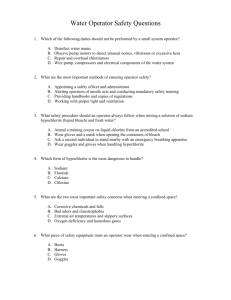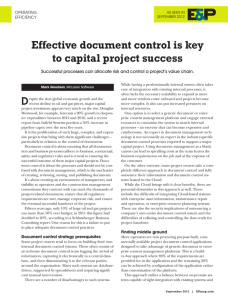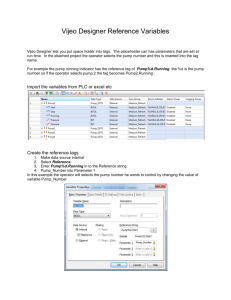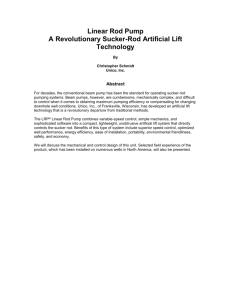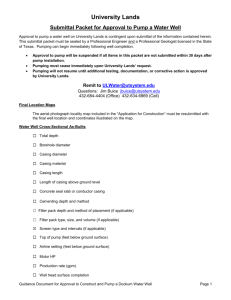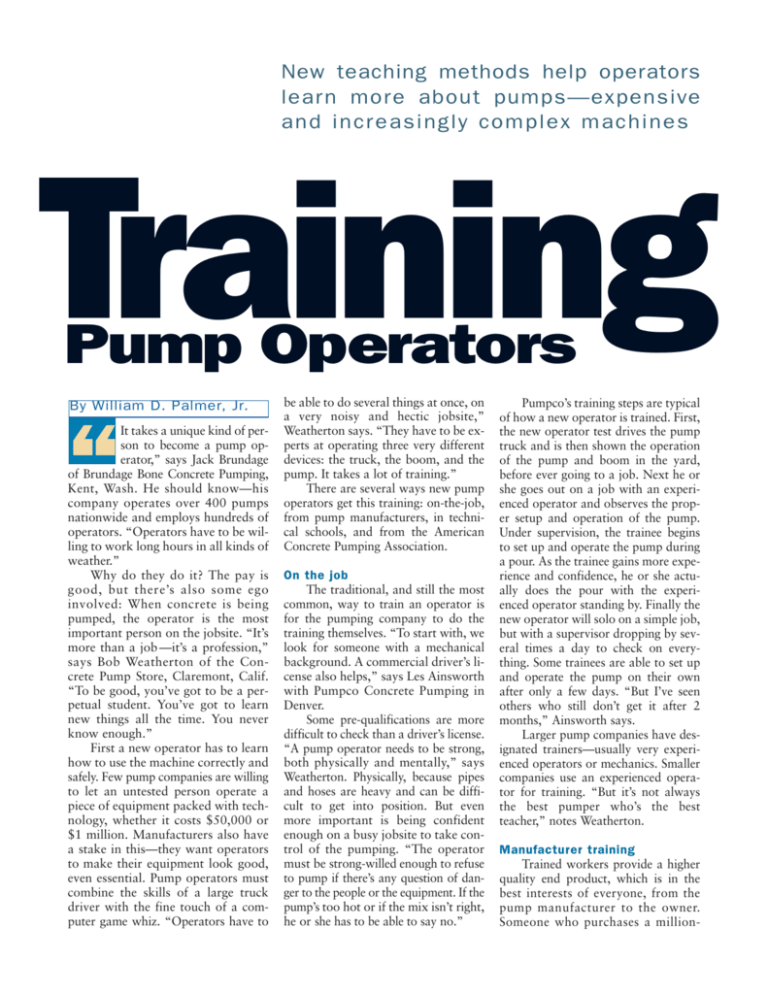
New teaching methods help operators
lear n more about pumps—expensive
and incr easingly complex machines
Training
Pump Operators
By William D. Palmer, Jr.
“
It takes a unique kind of person to become a pump operator,” says Jack Brundage
of Brundage Bone Concrete Pumping,
Kent, Wash. He should know—his
company operates over 400 pumps
nationwide and employs hundreds of
operators. “Operators have to be willing to work long hours in all kinds of
weather.”
Why do they do it? The pay is
good, but there’s also some ego
involved: When concrete is being
pumped, the operator is the most
important person on the jobsite. “It’s
more than a job —it’s a profession,”
says Bob Weatherton of the Concrete Pump Store, Claremont, Calif.
“To be good, you’ve got to be a perpetual student. You’ve got to learn
new things all the time. You never
know enough.”
First a new operator has to learn
how to use the machine correctly and
safely. Few pump companies are willing
to let an untested person operate a
piece of equipment packed with technology, whether it costs $50,000 or
$1 million. Manufacturers also have
a stake in this—they want operators
to make their equipment look good,
even essential. Pump operators must
combine the skills of a large truck
driver with the fine touch of a computer game whiz. “Operators have to
be able to do several things at once, on
a very noisy and hectic jobsite,”
Weatherton says. “They have to be experts at operating three very different
devices: the truck, the boom, and the
pump. It takes a lot of training.”
There are several ways new pump
operators get this training: on-the-job,
from pump manufacturers, in technical schools, and from the American
Concrete Pumping Association.
On the job
The traditional, and still the most
common, way to train an operator is
for the pumping company to do the
training themselves. “To start with, we
look for someone with a mechanical
background. A commercial driver’s license also helps,” says Les Ainsworth
with Pumpco Concrete Pumping in
Denver.
Some pre-qualifications are more
difficult to check than a driver’s license.
“A pump operator needs to be strong,
both physically and mentally,” says
Weatherton. Physically, because pipes
and hoses are heavy and can be difficult to get into position. But even
more important is being confident
enough on a busy jobsite to take control of the pumping. “The operator
must be strong-willed enough to refuse
to pump if there’s any question of danger to the people or the equipment. If the
pump’s too hot or if the mix isn’t right,
he or she has to be able to say no.”
Pumpco’s training steps are typical
of how a new operator is trained. First,
the new operator test drives the pump
truck and is then shown the operation
of the pump and boom in the yard,
before ever going to a job. Next he or
she goes out on a job with an experienced operator and observes the proper setup and operation of the pump.
Under supervision, the trainee begins
to set up and operate the pump during
a pour. As the trainee gains more experience and confidence, he or she actually does the pour with the experienced operator standing by. Finally the
new operator will solo on a simple job,
but with a supervisor dropping by several times a day to check on everything. Some trainees are able to set up
and operate the pump on their own
after only a few days. “But I’ve seen
others who still don’t get it after 2
months,” Ainsworth says.
Larger pump companies have designated trainers—usually very experienced operators or mechanics. Smaller
companies use an experienced operator for training. “But it’s not always
the best pumper who’s the best
teacher,” notes Weatherton.
Manufacturer training
Trained workers provide a higher
quality end product, which is in the
best interests of everyone, from the
pump manufacturer to the owner.
Someone who purchases a million-
dollar piece of equipment rightfully
expects training to be included, and
most pump manufacturers provide
some initial operating training as well
as service training. Often the local distributor conducts this training.
Dave Hirt, with Reich Construction Equipment, says that the sale of
a pump includes a training expert to
work with new owners until they are
comfortable with the specific characteristics of the new pump. “Most of
the time, they are already familiar with
pumping. We work with them for 2 or
3 days, going through all the controls,
basic maintenance, troubleshooting,
the parts manual, and the major dos
and don’ts. Then we make sure they
know who to call if problems arise.”
Of all the pump manufacturers,
Schwing conducts the most ambitious
training program. It conducts service
seminars on three levels: operator
(Level 1), mechanic (Level 2), and
advanced mechanic (Level 3). Courses
at each level are held two or three
times each year at Schwing’s training
center in St. Paul, Minn. The registration fee is around $900. “All of the
training materials and programs are
sold to the customer at cost,” says
Schwing’s training director Phil Seere.
To supplement the seminars, or as
stand-alone self-paced study, Schwing
has an extensive collection of CDROMs on every aspect of servicing
booms and pumps.
Schwing’s newest training innovation is its Virtual Boom—a very realistic concrete pumping computer game.
At this year’s World of Concrete, Seere
gave me a quick lesson and then let me
take the controls. Using a real remote
pump and boom controller, this computerized pump is extraordinarily lifelike. I selected the 52-meter boom, then
started the truck engine. The engine
rumble grew softer as I moved away
from the truck to find a position that
would give the best perspective to
watch and control the pumping. I started with a basement wall pour, and
found that I’d positioned the truck
poorly—too close to power lines. Once
“It hurt to do it, but we took our best operator off
the pumps and made him a full-time trainer,” says
Rod Pugliese with Brundage-Bone in Denver. “He
even observes the veterans from time to time to
make sure they aren’t getting sloppy.”
the pump truck was moved to a better
location, I unfolded the boom one section at a time and awkwardly slewed
and extended the boom to position the
hose to begin pumping. Finally, a voice
yelled out, “OK, you’re ready to pump.
Go ahead!” I turned on the pump and
watched the wall fill with concrete.
Controlling the boom with the
two joysticks takes some practice. One
stick controls two boom sections, and
a third boom section and the slewing
are controlled by the other. As I finished pumping a second floor deck
slab, I slammed the boom into the
deck, earning a reprimand from the
hoseman: “Oh man, you need to go
work for the competition!”
Another Schwing training program is a virtual pumping “room” for
beginners, where the operator learns
the basic controls without the simulated pressure of a real jobsite. In this
part of the program, you learn to
pump into boxes from various positions and elevations and to best position yourself to see where the end of
the boom is in relation to your target.
Depth perception on the screen can be
as deceiving as it is on a real jobsite.
Other software packages teach the
operator how to determine if all systems and controls are working properly, and how to adjust the sensitivity of
the controls to personal preferences.
For pump mechanics, Schwing has
extensive service software to help troubleshoot a problem. The diagnostics system is so detailed that, for example, it
shows exactly where to put the leads of a
multimeter and what the meter should
read. Every circuit and every hydraulic
line is traced and its function is described.
Putzmeister also conducts an
extensive schedule of classes at its
headquarters in Racine, Wis., that are
primarily oriented toward maintaining
and servicing the equipment. Attendees are expected to arrive with a
basic working knowledge of concrete
pumps. Courses combining classroom
with hands-on training cover large line
pumps, trailer pumps, and boom inspection. These courses are free to
Putzmeister customers.
Technical colleges
Despite the best efforts of the
pumping companies to support technical college programs for operators,
Schwing’s Virtual
Boom allows operators-in-training to
become familiar
with the controls
before moving to a
real boom.
there is no current functioning program. That will change in May with
the initiation of a program at the Autry
Technology Center in Enid, Okla. (see
July 2000, p. 33). With support from
Pumpstar Concrete Pumps and several
local ready-mix companies, Autry
plans to start five students on a 3- to 4month-long program that will be computer-based but led by an instructor.
Instructor Casey Blaine says that the
program “pulls concepts from other
programs and tailors them to the
pumping industry’s needs. Our hope is
that the industry will recognize the program and provide feedback so that we
can give students the training they need
to be productive on the job.” This program will combine classroom instruction with co-op work at Pumpstar.
Schwing has, for the past 4 years,
supported a course for pump opera-
tors at Central Lakes College in
Staples, Minn. Similar to the program
being planned in Oklahoma, this program has unfortunately been suspended due to a lack of students.
American Concrete Pumping
Association
Members of the ACPA include the
top people at many of the largest concrete pumping companies in the
United States as well as the owners of
many small companies. In its continuing efforts to raise the level of professionalism across the industry, ACPA
has developed the following programs
and materials that emphasize that
pump safety and efficiency are completely intertwined:
■ Recommended training procedures for pump operators that includes a long checklist of things every
What does an operator need to know?
■ Commercial driving (leading to a CDL)
■ Diesel engines
■ Basic hydraulics
■ Basic electrical systems
■ Basic electronics
■ Schematic reading (hydraulic and electrical)
■ Basics of concrete, including mix design
■ Common pump and boom parts and how they function
■ General construction site safety
■ Safe pump and boom operating procedures (especially setup
and cleanout)
■ Preventative maintenance
■ Emergency jobsite troubleshooting and repair
This list is a compilation of the courses offered at community colleges and by the manufacturers.
operator should know.
■ The association’s lengthy list of
safety videotapes complements an operator’s training. “A lot of companies
will make the operator watch the
videos and sign off,” Weatherton says.
■ A series of safety posters reminds operators of safe practices such
as relieving the pressure before opening
a line, fully extending the outriggers,
and not standing on the hopper.
■ ACPA’s pump operator certification program “identifies experienced
operators and ensures recognition of
a concrete pump operator’s safety
awareness.” ACPA certification indicates that the operator knows the
book, although it does not indicate
that the worker is qualified to pump.
Two levels of certification in eight categories include safety, trailer pumps,
short booms, and large booms. A
“safety card holder” is someone who
has passed the examination but does
not yet have the required experience.
Once experienced, the operator can
upgrade to full certification. Certification can be an important part of
training. “When we hire an operator,”
says Ainsworth, “it’s on a 90-day probation, and we expect operators to get
ACPA certified within that 90 days.
They won’t get a raise until they do.”
■ ACPA has developed a complete
safety training series (see box) that a
pumping company can conduct in two
ways: the company can administer the
program itself, or an operator can complete the course through Classroom
America. With Classroom America, the
pumper gets a workbook and studies the
materials at his or her own pace. When
finished with each of the 12 chapters,
the student calls an 800 phone number
to take an automated over-the-phone
quiz. The company then gets a report on
how its employees performed on the
quiz, emphasizing areas where an
operator is weak and might need some
extra help.
Training of pump operators
improves the quality of concrete and
makes the jobsite safer. But training
is also defensive—ACPA estimates
that the average accident costs
$250,000 and possibly much more if
the courts get involved. When there’s
a problem on a job, or someone gets
hurt, and the lawyers drag everyone
into court, a documented training
program gives pumping companies
and manufacturers a much stronger
hand. ■
For further information
American Concrete Pumping Association,
614-431-5618, www.concretepumpers.com,
or circle 1 on the reader service card
Autry Technology Center, 580-242-2750,
or www.autrytech.com, or circle 2 on the
reader service card
Pumpstar, 580-548-2723,
www.pumpstar.com, or circle 3 on the
reader service card
Putzmeister America, 262-886-3200,
www.putzmeister.com, or circle 4 on the
reader service card
Reich Construction Equipment, 803-9801120, www.reichpumps.com, or circle 5
on the reader service card
Schwing America Inc., 651-429-0999,
www.schwing.com or circle 6 on the
reader service card
ACPA’s Safety Training Series
■ Job setup
■ Before driving to the job
■ Pumping the job
■ Co-worker safety
■ Moving the pump during the pour
■ High-tension wires
■ The basics when working with a pipeline
■ Cleaning a separately laid pipeline
■ Cleaning the pump
■ Pinch points and cut-off points
■ Maintenance issues
Publication #C01D024
Copyright © 2001 Hanley-Wood, LLC
All rights reserved


